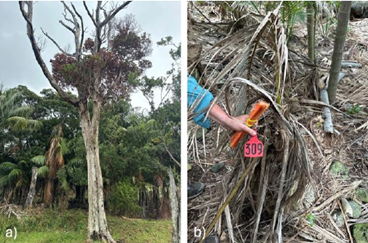Phytophthora (root rot fungus) April 2024 test results
Delimiting surveys were undertaken in April to determine the extent of the spread of the plant pathogen Phytophthora on the Island.
Analysis by the Royal Botanic Gardens’ PlantClinc found about 52% of the soil samples from 20 broad geographic areas were positive for Phytophthora, with nine different species of the pathogen detected. Of these species, three are of noted concern to Australian environments and agriculture, particularly P. cinnamomi and P. multivora.
The results show that Phytophthora is now distributed throughout the settlement area and has established within the Permanent Park Preserve at North Bay, Smoking Tree Ridge and at the start of the Mt Gower track.
The spread is most likely linked to human activities, although it can be dispersed by water moving through infected soil.
How you can help
Phytophthora can cause devastating impacts to native ecosystems and agriculture, resulting in disease, death and possible extinction of susceptible species. To limit your impact please ensure you:
- Arrive clean, leave clean – always use available wash down or hygiene stations when entering and exiting tracks, and when present along tracks.
- Obey signs and do not enter the fenced off quarantine exclusion zones located near the golf course.
- Brush soil off vehicles, bikes, boots, and camping gear before entering an uninfected area and after leaving an infested area – don’t wait until you get home to clean them.
- Stay on designated roads and tracks. Vehicles, bikes, and people have the potential to pick up infected soil and transfer it to uninfected areas.
LHIB management procedures
In June 2023, regular testing indicated that Phytophthora had spread beyond its previously known single infection site on the Island.

Scientists from the PlantClinic collected 107 soil samples across the Island (white dots) between 5-11 April 2024, with 56 testing positive for Phytophthora
A report has been delivered to LHIB with management recommendations focusing on preventing further spread in the PPP, reducing the biosecurity risk from future introductions, and improving hygiene measures and protocols, including at the entrances to the PPP.
Many of these actions have been implemented by the LHIB already. You may notice additional boot scrub stations around the island near known infections, and additional hygiene protocols have been implemented around the Board.
Additional delimiting surveys will take place in the next few months to help refine our management actions to ensure that we limit the spread of this destructive disease and protect our unique environment. These surveys will focus on determining whether Phytophthora is established within the southern mountains.
Further testing of the susceptibility of endemic plant species to Phytophthora will also be undertaken to help understand risks and prioritise conservation efforts.

(a) Phytophthora cinnamomic-positive tree with dieback in Soldier’s Creek drainage area (b) Phytophthora cinnamomic-positive palm with dieback on the Mt Gower track
Head here for more information about Phytophthora and its devastating impacts.
For any questions or concerns, please contact Cristina Venables, Team Leader World Heritage ([email protected]), Nicola Fuller, Team Leader Flora and Weeds ([email protected]), or Darryl Birch, Team Leader Biosecurity ([email protected]).
